外研版必修4Module2 Getting around in Beijing课文学案
- 格式:doc
- 大小:55.00 KB
- 文档页数:2
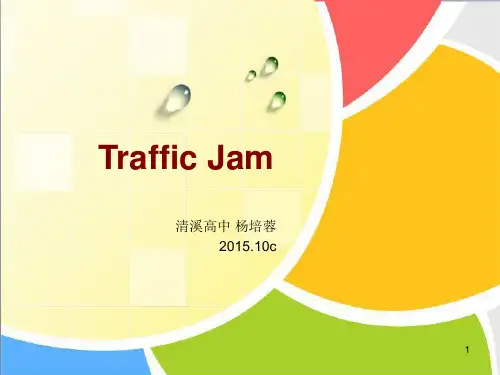
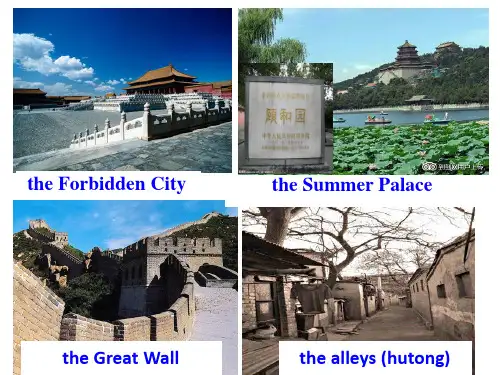
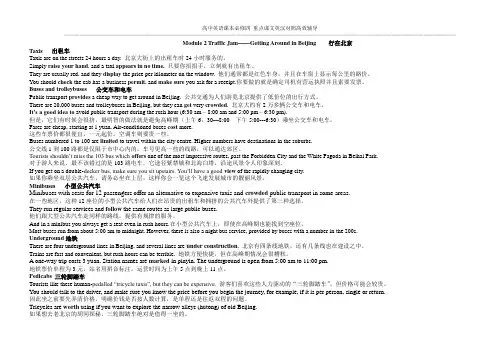
高中英语课本必修四重点课文英汉对照高效辅导—————————————————————————————————————————————————————————————————————————Module 2 T raffic Jam——Getting Around in Beijing 行在北京T axis 出租车Taxis are on the streets 24 hours a day. 北京大街上的出租车时24小时服务的。
Simply raise your hand, and a taxi appears in no time.只要你招招手,立刻就有出租车。
They are usually red, and they dis play the price per kilometer on the window. 他们通常都是红色车身,并且在车窗上显示每公里的路价。
Y ou should check the cab has a business permit, and make sure you ask for a receipt.你要做的就是确定司机有营运执照并且索要发票。
Buses and trolleybuses 公交车和电车Public transport provides a cheap way to get around in Beijing. 公共交通为人们游览北京提供了低价位的出行方式。
There are 20,000 buses and trolleybuses in Beijing, but they can get very crowded. 北京大约有2万多辆公交车和电车。
It’s a good idea to avoid public transport during the rush hour (6:30 am – 8:00 am and 5:00 pm – 6:30 pm).但是,它们有时候会很挤,最明智的做法就是避免高峰期(上午6:30---8:00 下午5:00---6:30)乘坐公交车和电车。
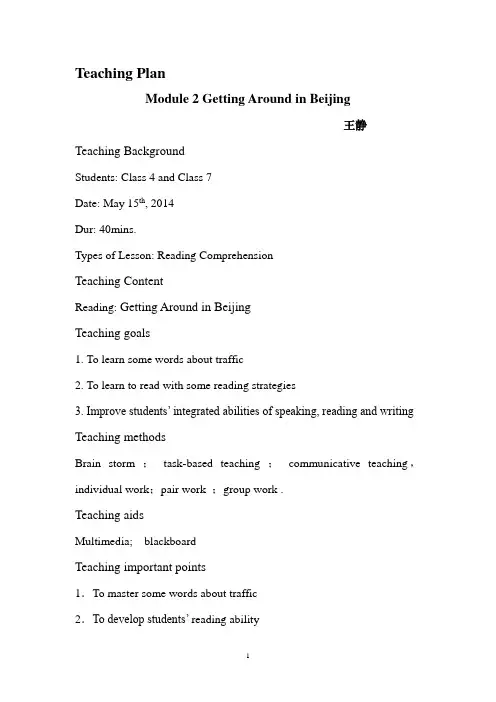
Teaching PlanModule 2 Getting Around in Beijing王静Teaching BackgroundStudents: Class 4 and Class 7Date: May 15th, 2014Dur: 40mins.Types of Lesson: Reading ComprehensionTeaching ContentReading: Getting Around in BeijingTeaching goals1. To learn some words about traffic2. To learn to read with some reading strategies3. Improve students’ integrated abilities of speaking, reading and writing Teaching methodsBrain storm ;task-based teaching ;communicative teaching,individual work;pair work ;group work .Teaching aidsMultimedia; blackboardTeaching important points1.To master some words about traffic2.To develop students’ reading abilityTeaching difficult pointsHow to make students fully understand the textTeaching procedures:Step 1 Lead in1. Arouse students’interest in the topic Getting around in Beijing by showing them some pictures of places of interest in Beijing.The Bird Nest; The Great Wall; The Forbidden City; Water Cube; The White Pagoda in Beihai Park; The Narrow Alleys (hutong)2. Brainstorm means of transportation, and then show some pictures of transport means to review and learn some words related to transport means and traffic .Trolleybus; double-decker bus; minibus; underground / subway; pedicab/ tricycleStep 2 Pre-readingAsk students to match the words in the box with their meanings.Cab destination fare get around passenger receipt return (n) route rush hour seat single (n) permit (n)1.to go from one place to another2.a person who uses public transport3. (A ticket for) a two-way journey4. The road the public transport service uses regularly5. The busiest time of day6. The price of a ticket7. (A ticket for) a one-way journey8. The place you want to go to9. A document which shows you have paid for something10. A place to sit11. Another word for taxi12. A document which gives you the right to do somethingThe answer: 1.get around 2.passenger 3. return 4.route 5. rush hour6. fare7. single8. destination9.receipt 10. seat 11. cab 12.permitStep 3 Fast-readingRead the passage quickly and decide how many transport are mentioned in the text. What are they?Getting Around in Beijing: Taxis; Buses and trolley-buses; Mini-buses; Under-ground; Pedicabschoose the best answers.1. The rush hour means _____.A. 6:00 am - 8:00 am and 5:00 pm - 6:30 pmB. 6:30 am - 8:00 am and 5:00 pm - 6:30 pmC. 6:00 am - 8:30 am and 5:00 pm - 6:00 pmD. 6:00 am - 9:00 am and 5:30 pm - 6:30 pm2. If you want to have a good view of the rapidly changing city, you should take _____.A. a taxiB. a minibusC. a double-decker busD. a pedicab3. If you want to get a seat even in rush hours, you should take _____.A. a taxiB. a minibusC. a double-decker busD. a pedicabThe answer: B C BStep 4 Detailed-readingL et’s read the passage part by part1.Read the first part and answer the following questions1. How easy is it to find a taxi in Beijing?Raise your hand, and a taxi appears in no time.2.What is taxi like in Beijing?They’re red.2. Read the second part and decide if these sentences are true(T) or false(F)1) There are 20,000 buses and trolley buses, so they are not crowded.2) Air-conditioned buses cost less than ordinary ones.3) Buses numbered 1 to 100 are limited to travel outside the city.4) If you sit upstairs in a double-decker bus, you’ll have a good view of the city.5) There is not a night bus service at all.The answer: F F F T F3.Read the third part and choose the best answer1) How many people can get in a minibus?A. 12B. 1C. 4D. 502) Minibuses offer an alternative to _____taxis and _____ public transport.A. expensive, emptyB. cheap, emptyC. expensive, crowdedD. cheap, crowded3) Which transport can you take if you want to get a seat in rush hours?A. BusesB. UndergroundC. PedicabsD. MinibusesThe answer: A C D4.Read the forth part and fill in the blanks1) Several underground lines are under______________.2) Trains are fast and ___________.3) A one-way trip ______three yuan4) The ____________is open from 5am to 11pmThe answer:construction convenient costs underground5.Read the fifth part and choose the best Choice1) Which transport can you take if you want to explore the narrow alleys of old Beijing?A.BusesB.UndergroundC. PedicabsD. Minibuses2) Before you begin your journey by pedicabs, you should _________.A. stay at the stationB. make sure you know the priceC. buy a ticketD. ask for receiptThe answer: C BStep 5 Post-readingDo it in groupsStep 6 DiscussionWhat transport do you use to get around in Beijing? Why?The students can use the following structure(in groups)I get around in Beijing by…. because it is …The students can write down the sentences and then show to their classmates.Step7 SummaryWe have comprehend this text and know some transport.Step 8 HomeworkTry to find some information about the transport on the Internet. Then show it to the classmates tomorrow。
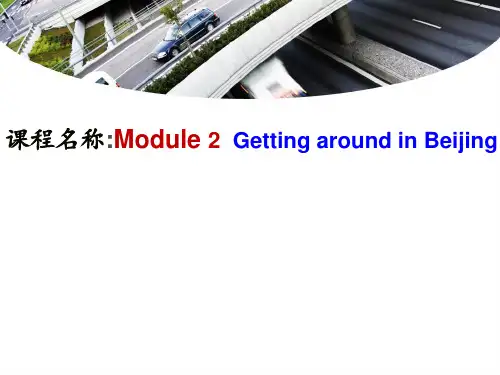
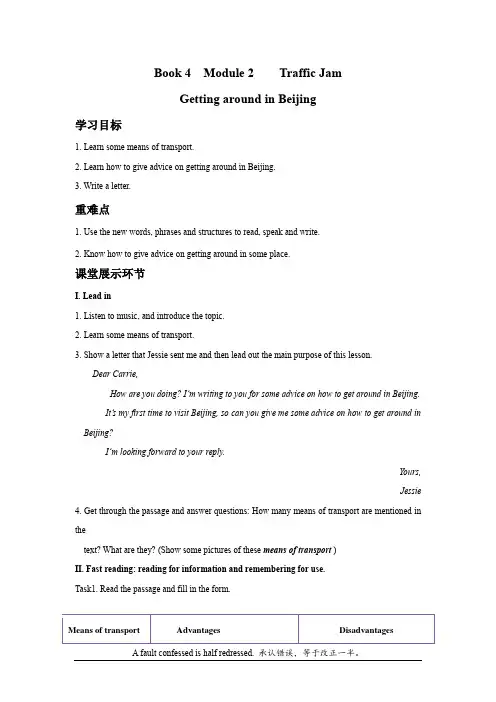
Book 4 Module 2 Traffic JamGetting around in Beijing学习目标1. Learn some means of transport.2. Learn how to give advice on getting around in Beijing.3. Write a letter.重难点1. Use the new words, phrases and structures to read, speak and write.2. Know how to give advice on getting around in some place.课堂展示环节I. Lead in1. Listen to music, and introduce the topic.2. Learn some means of transport.3. Show a letter that Jessie sent me and then lead out the main purpose of this lesson.Dear Carrie,How are you doing? I’m writing to you for some advice on how to get around in Beijing.It’s my first time to visit Beijing, so can you give me some advice on how to get around in Beijing?I’m looking forward to your reply.Yours,Jessie 4. Get through the passage and answer questions: How many means of transport are mentioned in thetext? What are they? (Show some pictures of these means of transport )II. Fast reading: reading for information and remembering for use.Task1. Read the passage and fill in the form.Task 2. Three minutes to recite the advantages and disadvantages.III. Careful reading:game for sentencesIn this step, you should read the passage carefully and find out the sentences on giving advice. Then use them to make the dialogues.Task 1.Teacher and students make a dialogue.A: I am very interested in hutong of old Beijing. Which means of transport should I choose?B: …A: Why?B: Because hutong of old Beijing is too narrow for other means of transport; besides, pedicabsare friendly to environment. But make sure the price before your journey.Task 2. Three minutes to prepare the dialogues.( Hand out the little notes in advance)Task 3. Conclude the useful sentence structures on giving advice.VI. Summary: picture for memoryReview the means of transport and their advantages and disadvantages.V. Writing: language for use1 Make sure how to write a letterPara1: The purpose of writing a letter:(I’m writing to …)Para2:Our advice:(It’s a good idea…You’d better…You should…)Para3:Our wishes:( I hope/wish…)2. Show the standard of good compositions and assess your writings.Handwriting (6分)Vocabularies (6分)Sentences (7分)Structures (6分)3. Write a letter to Jessie.Dear Jessie:I am very pleasured/writing to give you some advice on getting around in Beijing.___________________________________________________________________________ ___________________________________________________________________________________________ ___________________________________________________________________________________________ ___________________________________________________________________________________________ ___________________________________________________________________________________________ ___________________________________________________________________________________________ ___________________________________________________________________________________________ ___________________________________________________________________________________________ ___________________________________________________________________________________________ ________________I wish you have a good time!Yours,Carrie V. Sublimation of the main ideaPlease use public transport to protect the environment.IV. HomeworkMake a travelling plan for me to travel in Liaocheng.Getting around in Beijing —学情分析1.学生经过高一阶段的英语学习,已经具备了一定的阅读技能,如查找细节信息,获取主要信息,抓住要点等。
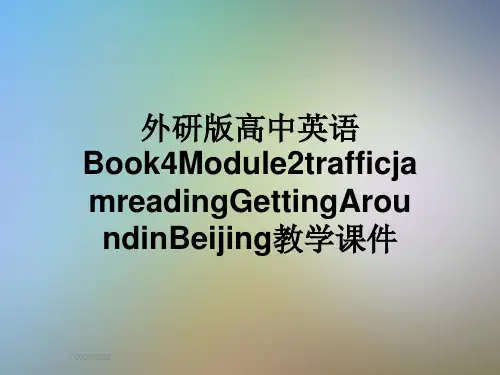

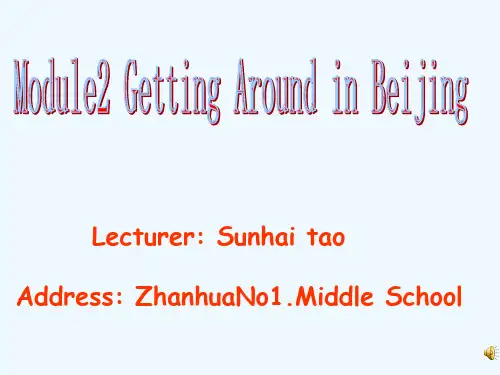
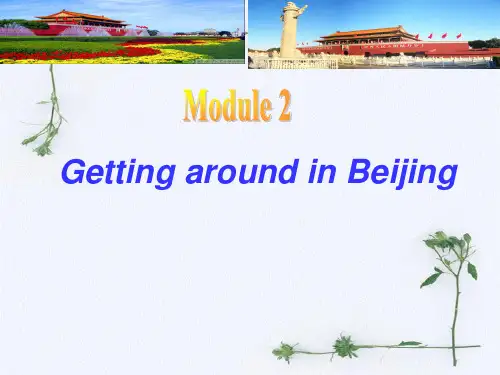
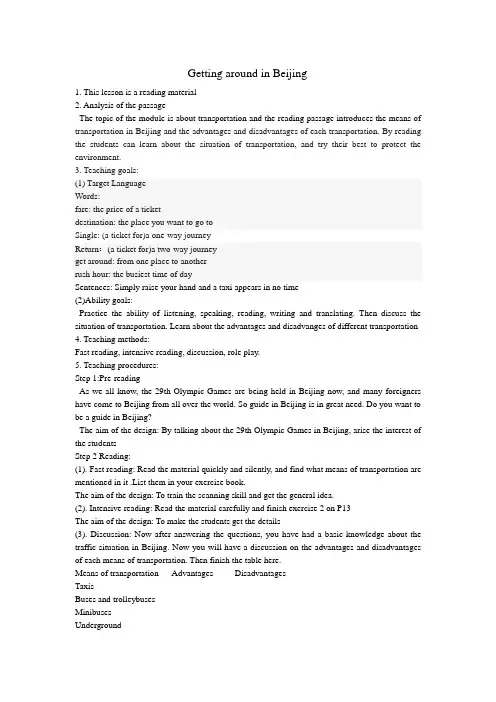
Getting around in Beijing1. This lesson is a reading material2. Analysis of the passageThe topic of the module is about transportation and the reading passage introduces the means of transportation in Beijing and the advantages and disadvantages of each transportation. By reading the students can learn about the situation of transportation, and try their best to protect the environment.3. Teaching goals:(1) Target LanguageWords:fare: the price of a ticketdestination: the place you want to go toSingle: (a ticket for)a one-way journeyReturn:(a ticket for)a two-way journeyget around: from one place to anotherrush hour: the busiest time of daySentences: Simply raise your hand and a taxi appears in no time(2)Ability goals:Practice the ability of listening, speaking, reading, writing and translating. Then discuss the situation of transportation. Learn about the advantages and disadvanges of different transportation 4. Teaching methods:Fast reading, intensive reading, discussion, role play.5. Teaching procedures:Step 1:Pre-readingAs we all know, the 29th Olympic Games are being held in Beijing now, and many foreigners have come to Beijing from all over the world. So guide in Beijing is in great need. Do you want to be a guide in Beijing?The aim of the design: By talking about the 29th Olympic Games in Beijing, arise the interest of the studentsStep 2 Reading:(1). Fast reading: Read the material quickly and silently, and find what means of transportation are mentioned in it .List them in your exercise book.The aim of the design: To train the scanning skill and get the general idea.(2). Intensive reading: Read the material carefully and finish exercise 2 on P13The aim of the design: To make the students get the details(3). Discussion: Now after answering the questions, you have had a basic knowledge about the traffic situation in Beijing. Now you will have a discussion on the advantages and disadvantages of each means of transportation. Then finish the table here.Means of transportation Advantages DisadvantagesTaxisBuses and trolleybusesMinibusesUndergroundPedicabs(4)Role-play: I will ask one student to act as a guide, the other a travaller.First, the teacher give a model. Then the students will discuss with their partner, and act out.The aim of the design: To get the students to use their knowledge freely.(5)Language points: useful words, phrases and some important sentence structures.a, Simply raise your hand and a taxi appears in no time.b, Fares starting at 10Y uan .c, be worth doing sth .The aim of design: make the students graspe the important sentence structures, improve their reading ability and help them to get a better understanding of the passage.Step 3. Post-readingWe know that as more and more cars appear, the traffic problems are becoming more and more serious. Now we will have a discussion: What can you do to help decrease or even control all kinds of traffic problems?Step 4. Teaching assessment: What have you learned by reading the passage?Step 5. Homework:(1). Read the passage again and remember the usage of important words and phrases as well as sentence structures.(2). Write a letter to the Mayor of Beijing, offering your suggestions to solve the traffic problems in Beijing.Blackboard design:nguage points:impressive, provide, convenientunder construction, get around, in no timebe worth doing2HomeworkWrite a letter to the Mayor of Beijing, offering your suggestions to solve the traffic problems in Beijing.。
全册高中英语必修4课文逐句翻译(外研版)1.必修四Module1 The City of the Future未来城市What will the city of the future look like?未来的城市会是什么样子呢? No one knows for sure, and making predictions is a risky business. 没有人确切的了解,预测也是一件很危险的事情。
But one thing is certain---they are going to get bigger before they get smaller.但是有一件事情是可以肯定的---他们将会先变大,然后再变小。
In the future, care for the environment will become very important as earth's natural resources run out. 在未来,爱护环境将会很重要,因为地球的资源将濒临枯竭。
We will use lots of recycled materials, such as plastic, aluminum, steel, glass, wood and paper, and we will waste fewer natural resources. 我们将会使用大量的可回收材料,例如,塑料、铝、钢铁、玻璃、木头和纸。
我们浪费自然资源的程度将会有所减弱。
We will also have to rely more on alternative energy, such as solar and wind power.我们也将不得不更多地依赖其他能源。
例如,太阳能和风能。
All this seems certain, but there are plenty of things about city life in the future which are not certain. 所有的这些似乎是肯定的,但是还有许多关于城市生活的事情仍是未知的。
1.Fast reading
1. Read the passage and find what means of transport are mentioned in it.
2.Who might care about the transportation information ?
Careful reading
1. If you want to explore the narrow alleys of old Beijing, you should choose__________
A.taxis
B. minibuses
C. pedicabs
D. underground
2. The rush hours include _________
A. 5:30----8:00 in the morning
B. 4:00----5:30 in the afternoon
C. 6:30 am----8:00 am and 5:00pm----6:30pm
D. 8:00 am----9:00 am
3. Tourists shouldn’t miss the 103 bus because_________
A. The fare is cheap, at 1 yuan
B. You always get a seat even in rush hours
C. It is fast and convenient
D. It offers one of the most impressive routes
4. When you take a taxi in Beijing, you should________
A. Bargain with the driver
B. Define the price per kilometer
C. Talk to the driver
D. Check the business permit and ask for a receipt
1.Simply raise your hand, and a taxi appears _____ ______ ______.
2. You should check the cab has a business ________, and ______ ______ you ask for a receipt.
3. Public transport provides a cheap way to ______ _______ in Beijing.
4._______ are cheap, starting at 1 yuan.
5.Buses numbered 1 to 100 ___ _______ __travel within the city centre.
6.You’ll ______ ______ ______ ______ _______ the rapidly changing city.
7. There are four underground lines in Beijing, and several lines are _________
8. Tricycles _______ _______ _______ if you want to explore the narrow alleys (hutong) of old Beijing.
9.It’s ______ ______ ______ to avoid public transport during the rush hour.
10. If you ______ ______ a double-decker bus, make sure you sit upstairs. Language Date Bank
1. It’s a good idea to avoid public transport during the rush hour.
It is + a (an) + n. + to do sth. it:________主语to do sth.:__________主语eg.处理这件事是我们的责任。
____________________________________. eg.下面该轮到你背课文了。
____________________________________.
2.Public transport provides a cheap way to get around in Beijing.
provide sth ______sb The government provides / supplies these
orphans ______food and clothes.
provide sb ______sth Our parents provide food ______us.
3. Buses numbered 1 to 100 are limited to travel within the city centre.
我愿意有限度地帮助你。
I’m willing to help you___________.
我会无限度地帮助你。
I’ll help you____________.
4. You’ll have a good view of the rapidly changing city.
have a view of:________ have a good view of___________
Eg.我看不清舞台。
I don’t __________________ the stage.
5. There are four underground lines in Beijing, and several lines are under construction.under 一词后常跟名词,表示主语所处的状态
The road is under repair. Don’t worry ---- everything is under control! 6.Tricycles are worth using if you want to explore the narrow alleys (hutong) of old Beijing.
他说这本书很值得一读。
_________________________________.
注意!_________________________________
Find some tips that the writer gives to visitors in Para. 1, 2
课文中找出笔者给游客提建议的句子
提建议:
1.
2.
3.
4.
5.
6.。